Putting plexiglass around a gazebo provides extra protection from the weather and is a great way to enjoy your outdoor space all year long and get more use out of it.
You can do this project with just a few simple tools and supplies, so it’s a good way for anyone to improve their outdoor living space on a budget.
This article will show you how to use plexiglass to cover your gazebo. Whether you have done DIY projects before or not, you will find the information you need to put plexiglass around your gazebo successfully.
Tools you need:
Putting plexiglass around a gazebo can be a fairly easy-to-do-it-yourself project, but you will need the right tools to make it work. Here are the most important things you’ll need for this project:
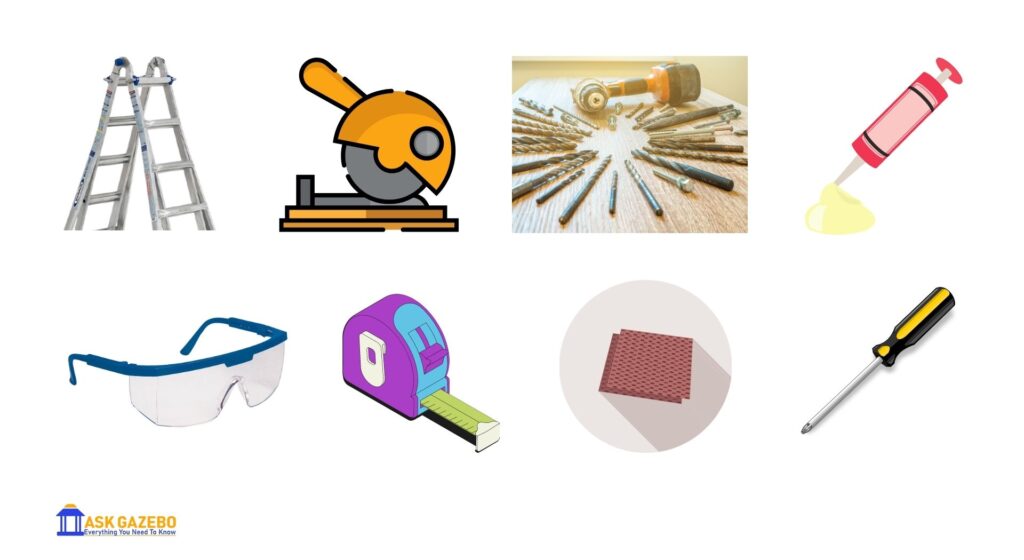

- Tape measure: To determine the size of the plexiglass panels you will need, you will need to measure your gazebo accurately.
- Marker or pen: To draw lines on the Plexiglas panels, so you know where to cut them.
- Cutting tools: You’ll need a circular saw, jigsaw, or a special tool for cutting plexiglass to cut the panels.
- Sandpaper: After cutting the plexiglass, you will use sandpaper to smooth rough edges.
- Screws and a screwdriver or drill: To attach the plexiglass panels to the gazebo’s frame, you will need screws and a screwdriver or drill.
- Weatherstripping or silicone sealant: To keep water from getting in between the panels and the gazebo.
As plexiglass can be sharp, ensure you have safety gear like gloves and eye protection.
Getting the Gazebo Ready
Before putting plexiglass around your gazebo, ensure the structure is ready. Here are the steps that you need to take:
Getting the gazebo’s size: You will need to measure the gazebo’s height, width, and length to determine the size of the plexiglass panels you need.
Consider where any support beams or posts are and how much space you want between the plexiglass panels and the gazebo frame.
Clean the surface of the gazebo: Before you start putting the plexiglass panels on the gazebo, it is a good time to clean it. It will ensure that the panels stick well and that nothing gets stuck between them and the frame.
Wipe the gazebo down with a damp cloth, making sure to get rid of any spider webs or other junk that might be there.
Deciding on the Plexiglass Panels’ Design and Layout: After you’ve measured the gazebo and cleaned the top, you can start planning how the plexiglass panels will look and be put together.
Think about things like where the sun is and which way the wind blows, as well as any views or landscapes you want to keep in view.
Consider thinking about how your gazebo looks and pick a layout that goes with it.
It’s also a good idea to draw a rough sketch of your design on paper to see what you’re trying to make. It will also help you figure out how many plexiglass panels you will need and how big each one needs to be.
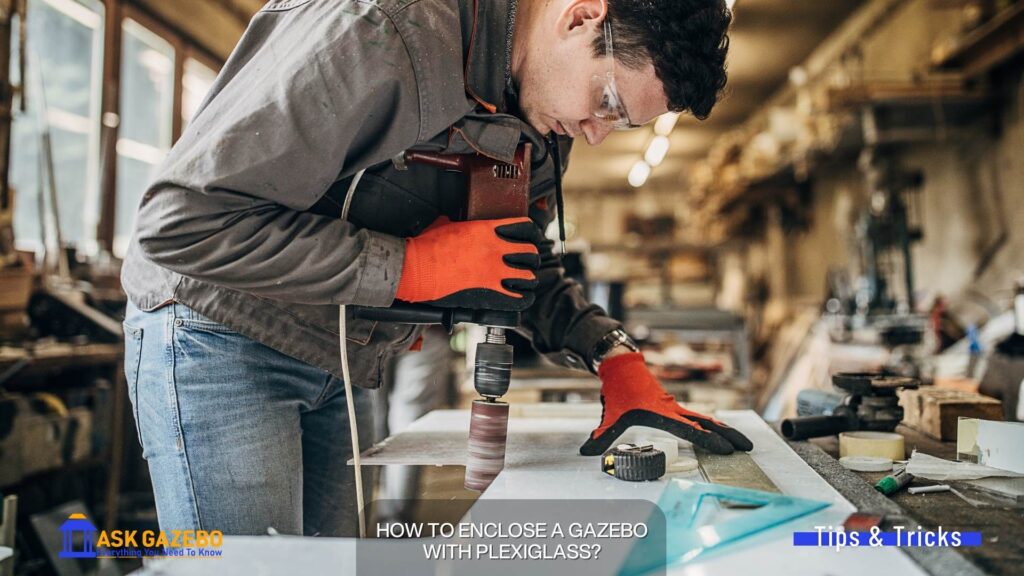

Putting the Plexiglas panels in place
You can start putting up the plexiglass panels when your gazebo is ready. Here are the steps that you need to take:
A. Cut the Plexiglas panels to size:
Cut the plexiglass panels to the right size using the measurements you took. Make sure to wear gloves and eye protection when cutting the panels since plexiglass can be sharp.
You can use a circular saw, a jigsaw, or a tool made just for cutting plexiglass, depending on what tools you have.
B. Sanding the Plexiglas Panels’ Edges:
Use sandpaper to smooth out rough edges after cutting the panels. It will help keep you from getting hurt and make sure the job looks like a pro did.
C. Attaching the Plexiglas panels to the gazebo frame:
After cutting and sanding the panels, it’s time to put them on the gazebo’s frame.
Attach the panels to the gazebo with screws and a screwdriver or drill. Make sure the screws are tight enough.
If you use weatherstripping or silicone sealant, put it along the edges of the panels and the frame of the gazebo to keep water from getting in.
D. (Optional) Installing hinges and locks:
You should put hinges and locks on the panels if you want to take them off to clean or fix them. It will make it easy to take off and back on the panels as needed.
By putting up the plexiglass panels, you will make a space protected from the weather and make your outdoor living area more comfortable.
Note: Plexiglass is fragile and easy to scratch, so be careful when you handle it. Be gentle with it and try not to bend or press on it, especially near the edges. If you don’t know if you can handle the plexiglass, you should hire a professional to do the installation.
Gazebo plexiglass enclosure design ideas:
Here are a few DIY plexiglass design ideas to enclose your gazebo.


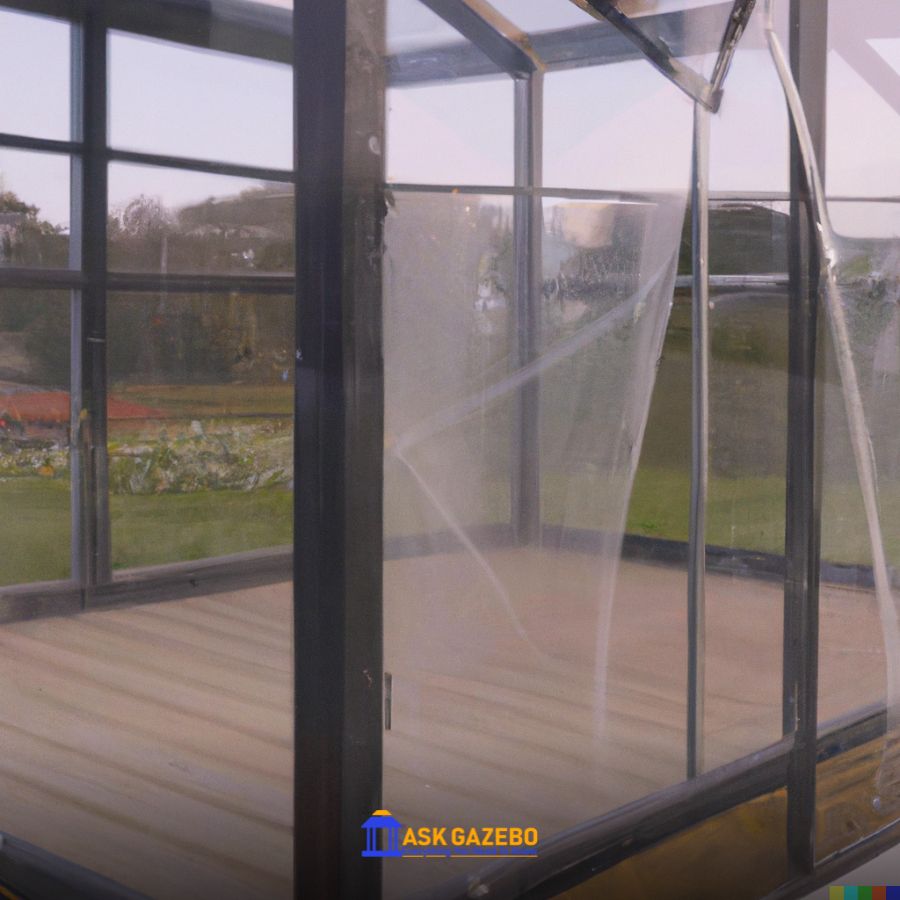

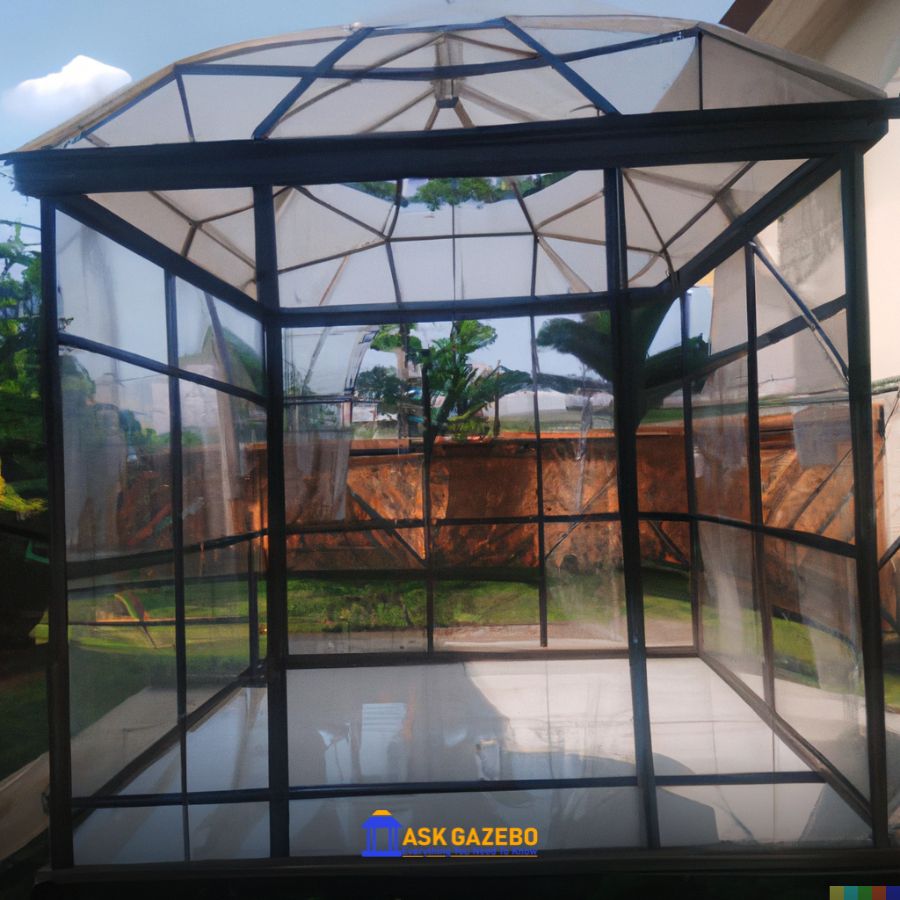

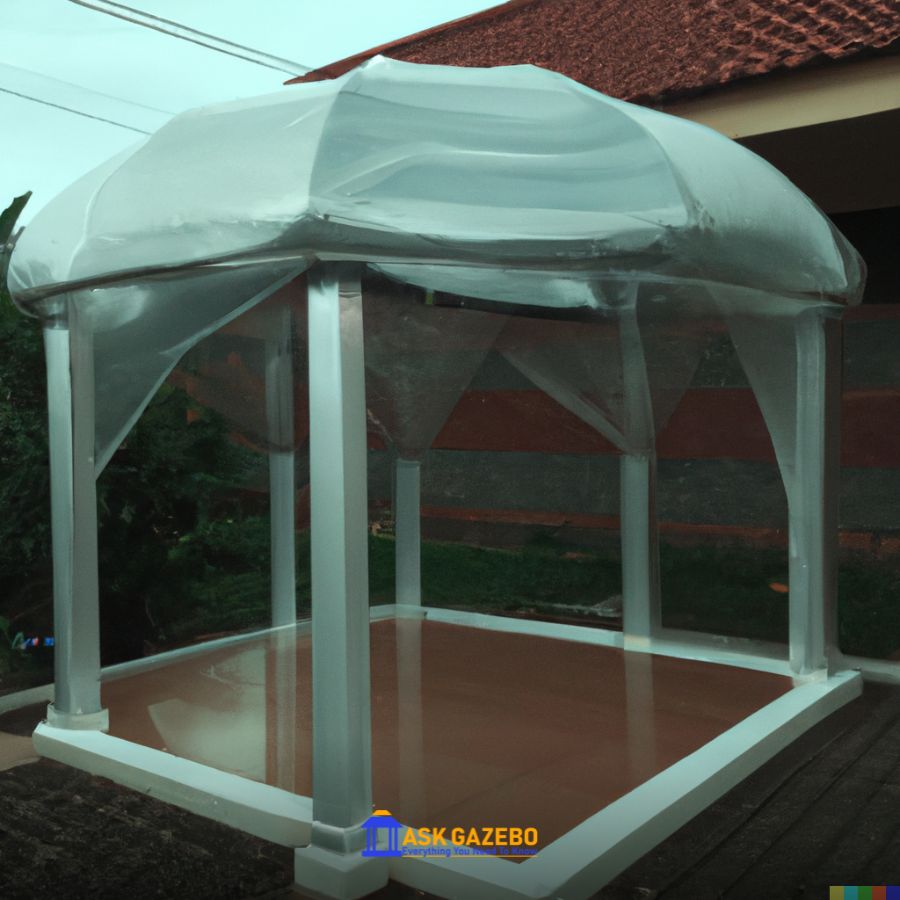

The Final Touches
After you’ve put up the plexiglass panels, it’s time to finish this project. Here are some ideas and tips to help you make the most of your new space:
Adding blinds or curtains:
Consider putting up curtains or blinds if you want more privacy and shade. These can be hung from the gazebo’s frame or poles, and they can be opened or shut as needed.
Choose blinds or curtains that match the style of your gazebo and go with the rest of your outdoor decor.
Installing Lighting:
If you want to use your gazebo at night, add lights.
String lights or lanterns can create a warm and inviting atmosphere. You can also install lights on the wall or ceiling for more functionality.
Explore
Best Solar Lights For Gazebos in 2024
The Ultimate Buying Guide for Solar Lights for Your Gazebo: From Energy Efficiency to Installation, We’ll Help You Decide.
Adding Things:
Add chairs, tables, and outdoor sofas to make the most of your new space. Choose furniture that fits the style of your gazebo and outdoor living area, is comfortable, and will last.
Home Decor:
Lastly, decorate your gazebo with personal touches like potted plants, rugs, or outdoor art. These can help make your gazebo feel more like an extension of your home by making it warm and cozy.
By putting these finishing touches on your gazebo, you can turn it into a useful and comfortable place to live outside. You will enjoy spending time in your new space, whether you are having people over or just reading a good book.


Subscribe For More Gazebo Videos!
Ask Gazebo
Tips For Enclosing A Gazebo With Plexiglass:
Here are some practical tips to help with your project:
- Before you purchase your plexiglass, make sure to accurately measure the size of your gazebo to ensure that you buy the right amount of material.
- UV rays can cause plexiglass to turn yellow and become brittle over time, so make sure to choose a UV-resistant option to ensure longevity.
- Plexiglass is heavier than screens, so properly support it with a sturdy frame to prevent sagging or breaking over time.
- If you want to simplify the installation process, consider using a self-supporting design for your plexiglass enclosure.
- To prevent air and water from entering the gazebo, properly seal the plexiglass’s edges to create a tight and secure fit.
Plexiglass Vs. Screen For Gazebo Enclosure:
Regarding enclosing a gazebo, there are two popular options: screens and plexiglass. Both options have unique pros and cons.
Screens offer a more natural feel and allow maximum ventilation but may not provide privacy and protection from the elements that plexiglass does.
On the other hand, plexiglass provides complete privacy and protection from the elements but may reduce ventilation and is more expensive.
Here are a few pros and cons:
Screen enclosures:
Pros:
- Screens allow for optimal airflow and are ideal for warm weather.
- Screens give the gazebo a natural, open, and airy feel, which can enhance the overall aesthetic of the outdoor space.
- Screens are more budget-friendly than plexiglass, making them a popular choice for many gazebo owners.
Cons:
- Screens do not offer complete privacy, which can be an issue if you’re looking for more privacy in your gazebo.
- Although screens offer excellent ventilation, they allow small debris and insects to enter the gazebo.
- Screens can become damaged over time and require frequent cleaning or replacement.
Allows for maximum ventilation
It provides a natural feel
Cost-effective
Not ideal for privacy
May need maintenance
Plexiglass enclosures:
Pros:
- Plexiglass enclosures offer complete privacy, which is great for those who want a secluded and protected outdoor space.
- Plexiglass protects from the elements, making it ideal for those who want to enjoy their gazebo all year round.
- Unlike screens, plexiglass is much easier to clean and maintain, making it a great option for those who don’t want to spend much time on maintenance.
Cons:
- Plexiglass is more expensive than screens, making it a more expensive option for those on a budget.
- Plexiglass enclosures reduce ventilation, making them less ideal for warm weather.
- Plexiglass is heavier and more difficult to install than screens so it may require additional support and installation efforts.
Provides privacy
Protection from the elements
Easy to clean
More expensive
Decreased ventilation
Harder to install
Screens are the best option if you want a more natural, open, and airy feel. However, plexiglass might be the way to go if you want more privacy and protection from the elements.
You can also check How To Enclose A Gazebo With Screen?
FAQs
Can plexiglass stand up to rough weather?
Plexiglass can withstand the sun, rain, and wind because it is weather-resistant. But it’s important to keep it safe, so it doesn’t get damaged by strong winds or storms.
How do I cut plexiglass for a gazebo in the best way?
The best way to cut plexiglass for a gazebo depends on the tools you have. You can use a circular saw or a jigsaw to make clean, precise cuts in plexiglass.
How do I put the Plexiglas panels on the frame of the gazebo?
You can use screws and a screwdriver or drill to attach the plexiglass panels to the gazebo’s frame. Make sure the screws are tight, and you might want to use weatherstripping or silicone sealant along the edges to keep water out.
Can the plexiglass panels be taken off to clean or fix them?
If you put hinges and locks on the plexiglass panels, you can take them off to clean or fix them.
How do I put lights in my gazebo?
You can put lights in your gazebo by putting up string lights, lanterns, lights on the walls, or lights in the ceiling. Choose lighting that matches the style of your gazebo and outdoor living area and makes the space feel warm and inviting.
Conclusion:
In conclusion, adding plexiglass to your gazebo is a simple and effective way to make your outdoor living area bigger.
With the right tools and materials, it’s easy to add plexiglass panels to your gazebo and turn it into a functional and comfortable outdoor living space.
A gazebo with plexiglass walls is a perfect solution whether you want privacy, shade, or a place to relax.
By following the steps in this article and adding a few finishing touches, you can make a beautiful and useful outdoor living space that you will enjoy for years to come.








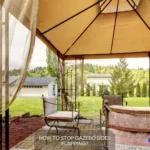
Will screwing or drilling into plexiglass will break it?
When installing plexiglass panels to enclose a gazebo, the plexiglass can crack or break if you are not careful while screwing or drilling into it.
Plexiglass is a type of acrylic plastic that is more flexible and less brittle than traditional glass, but it is still prone to cracking or chipping if it is mishandled or drilled incorrectly.
To avoid cracking it, use a drill designed to handle plexiglass, use low-speed settings, pause for a while when it gets heated, and be gentle while drilling.